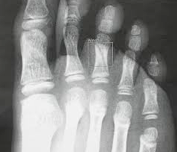As we are now approaching the height of the yachting season, I thought we might talk about common injuries while on-board and damaged toes are often high on the list of Yachty Injuries.
Broken toes are too frequently left unattended when the crew are busy with owners and guests. While you may not want to make a fuss of a perceived “minor” injury it is still most important to address the problem.
A broken toe may not initially seem broken at all and may take a day or two to show the symptoms particularly if you are still running around to fulfil your obligations.
During the first days the sufferer may feel that the best way is to “wait and see”. Unfortunately this will waste healing time should the toe have required immobilisation from the first instance.
Signs and Symptoms
A mild injury such as a small crack fracture may not show any sign of damage for as long as the first 24 hours whereas a severe break will show almost immediately.
The toe will eventually be swollen, red and painful to touch. Weight bearing and walking will be awkward and painful. Bruising (haematoma) will begin to develop and also seen on the underside of the foot with stiffness and pain on movement particularly noticed the next morning.
This x ray shows a break of a phalanx of the 3rd toe. This foot will show wide bruising on the top and the bottom of the foot after the injury and is an example of why, should you suspect a fracture, an x ray is most important because immobilization of this common fracture will be required for a minimum of 4 weeks.
Causes of Toe Fractures
Within our Yachting Community the most common cause of toe fractures is a stubbed toe on a cleat, block or companion way stair although there are plenty other options on board especially if it is prohibited to wear shoes above or below deck.
Another cause of toe fractures and severely damaged toenails is direct trauma, such as a heavy object falling on the toe. Once again the severity of this injury is frequently overlooked and may not show signs of the severity for a day or two after the trauma at which point medical attention should be sought to control infection and preserve the nail bed.
Breaks, Fractures and Cracks
I would like to explain once again that a Break or a Crack is still a Fracture.
The healing time of 4 to 8 weeks still applies with these bones even though they are small and the only thing that makes any difference is the extent of the fracture. By this I mean if the fracture is spiral, compound or comminuted. If the fracture is seen as complicated, ie. compound and-or comminuted then surgery may be required. Usually these types of fractures are pretty obvious with deformation of the toe and rapid swelling
A compound fracture is when the bone breaks through the skin.
A comminuted fracture is when there multiple breaks within the same bone and the two (comminuted and compound) often come together!
This is an example of a toe fracture which was left unattended. Note the red ring around the joint indicating a possibility of infection.
Compound and comminuted fracture of the big toe showing obvious deformity and requiring surgical attention.
Surgery for a comminuted fracture of the Big Toe, The screw may be removed after 8 to 12 months.
Immediate Care
Whether or not you suspect a fracture, the first line of treatment is an ice pack with elevation to help control any swelling.
Dunking the foot in and out of a bucket of iced water will have a speedy effect in both reducing the swelling and relieving pain.
Any skin lesion should be treated with saline cleansing and antiseptic with gauze and a light bandage. In this case an enclosed ice pack (such as a bag of frozen peas) should be used.
The affected toe can be gently strapped to its neighbour for stabilisation however if the toe is at an obvious broken angle, it is not advisable to attempt to reduce the fracture yourself and a trip to the nearest hospital for x ray and medical attention would be the best option.














0 Comments